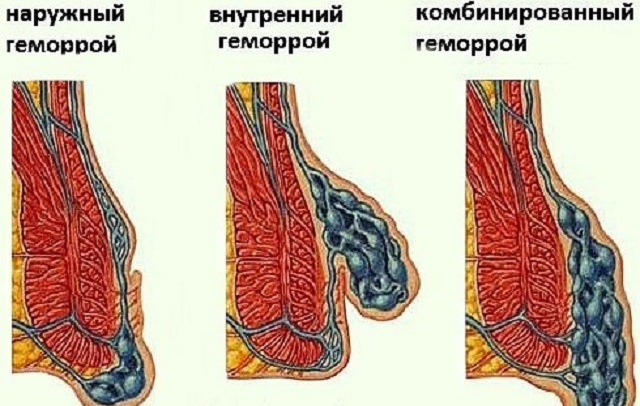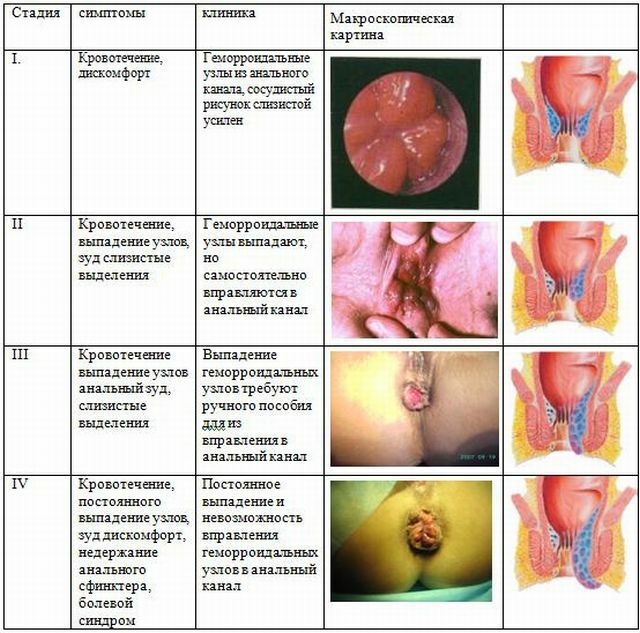 Hemorrhoids are a pathology that takes the leading place in frequency among diseases of the rectum.
Hemorrhoids are a pathology that takes the leading place in frequency among diseases of the rectum.
This morbid condition refers to a long-standing and is a powerful stress factor that affects the psychological and physiological components of a person's health.
Although the study of the problem has a long history, but even now there is no single point of view regarding the issues of pathogenesis, classification, course and therapy of hemorrhoids
Contents
- Varieties of the disease
- Congenital and acquired forms of the disease
- Acute and chronic - two sides of the same coin
- External and internalhemorrhoids
- As the disease progresses - step by step
- Methods of treatment
Types of the disease
Specialists from different countries or even cities are sometimes sufficientIt is difficult to correctly interpret each other if the conversation is about the classification and terminology of hemorrhoids. There are a lot of troubles in this area, but patients need to know the following.
The mechanism of hemorrhoids is:
- congenital;
- is acquired, which in turn is primary and secondary.
At the location of the hemorrhoids:
- external( subcutaneous);
- internal( submucosal).
The clinical course of hemorrhoids is divided into:
- acute;
- is chronic.
Acute and chronic hemorrhoidal disease is also subdivided into stages.
Congenital and acquired form of
disease Although heredity does not directly cause hemorrhoids, it is a provoking factor. To aggravate the disease or promote its  development may genetic deviation - an inherited pathology of the structure of the hemorrhoidal veins.
development may genetic deviation - an inherited pathology of the structure of the hemorrhoidal veins.
By nature, the weak walls of the veins due to the stagnation of venous blood under its pressure are often deformed, stretched and form internal and external nodes. If the disease was in the parents, then it is likely that it can manifest in children.
Acquired hemorrhoids are primary and secondary. The primary form develops as an independent disease due to impaired blood flow in the pelvic region and blood stagnation, while the secondary form is a symptom or complication of another pathology.
Acute and chronic - two sides of the same
medal The acute hemorrhoid clinic is characterized by pain syndrome and local changes in the form of thrombosed internal and external hemorrhoids.
Severity of pain depends on the severity of the disease. In addition to pain in the anus and compaction of the nodes, patients complain of a feeling of an alien body, itching, burning sensation while visiting the restroom.
With chronic hemorrhoids, the severity of the pain syndrome is weak, which gives the impression of a "minor" problem. This recurrent process can last several months or years and progress, if one ignores its symptoms.
After many months of illness in the structure of the cavernous bodies of the rectum, structural changes begin, suggesting the transition of the disease into a new form and manifested by bleeding.
Typical is the decrease in the tone of the rectal apparatus, in connection with which the nodes protrude and fall even more.
External and internal hemorrhoids
Internal hemorrhoids are not probed with a finger and are simply visualized only when the sphincter anus is atony or when the nodes fall out.
It can be diagnosed only by endoscopic examination, since the nodes are localized near the dentition line of the anal canal under the mucous membrane.
The course of the disease is painless, because the rectal mucosa innervates the vegetative fibers, which are not very sensitive to pain.
For internal hemorrhoids, the sensation of a partially emptied intestine, the departure of mucus and pus, a feeling of fullness in the intestine. Frequent relapses lead to the formation of an inconsistency of the internal sphincter of the rectum and incontinence of the stool.
With external hemorrhoids, the nodes form from the lower venous plexus and are located under the skin of the anus, just below the rectum-anal line.
The adjacent skin and anoderm, lining the anal canal, is abundantly provided with somatic sensory nerves, so when exacerbation of external hemorrhoids the pain has a pronounced character.
The presence of cones of different sizes, itching and discomfort in the anus, anal fissures that bleed are symptoms of external hemorrhoids during exacerbation.
In a calm state, external nodes do not cause discomfort, but pathology is dangerous due to the development of complications and requires treatment.

As the disease progresses - step by step
In practice, depending on the degree of node enlargement and the progression of dystrophic processes in the supporting fibromuscular framework, four stages of chronic hemorrhoids are usually identified:
- The nodes are practically not enlarged, they do not fall out and the patient feels only mild discomfort.A characteristic symptom is the secretion of blood from the anus during the emptying of the intestine and a slight swelling in the anus.
- Inflamed hemorrhoidal nodes from time to time drop out , but enter the anal canal on their own. When straining there is pain in the anus, symptomatology( burning, itching) is worse.
- The nodes fall out not only during defecation, but also under physical exertion of the , require manual repositioning. Emptying the bowel is accompanied by severe pain. Of the complications, thrombosis may develop.
- Hemorrhoids regularly fall out from the anal canal .They can not be corrected due to a strong increase in size and weakening of the connective tissue. They look like big cyanotic cones. This stage is characterized by regular bleeding during the emptying of the intestine. The anal opening does not completely close, therefore, a leakage of mucus is observed, which irritates the fallen nodes and skin, causing itching.

Acute hemorrhoids in its clinical course also has three stages:
- Against the background of absence of the inflammatory process of , thrombosis of external and internal hemorrhoid nodes , painful upon palpation, is observed. Nodules small, dense, superficial, cyanotic. Pain syndrome is not expressed. Disturb mucoid-hemorrhagic discharge, itching, minor bleeding is possible.
- In the second stage of , the inflammatory process of develops. Inflammation captures the tissue adjacent to the affected hemorrhoids. When sitting and walking, as well as during and after bowel movement, severe pain, discomfort in the anus is disturbing the patient. Because of a spasm of the external sphincter of the rectum, the urge to defecate may disappear.
- Thrombosis of hemorrhoids leads to development of inflammation of subcutaneous tissue and perianal skin .Palpation is impossible, since the entire anus is a swollen area and even a slight touch to it causes severe pain. On the perimeter of the anus, large dense crimson cones are visualized, areas of necrosis can be observed. The third degree is an indication for immediate medical intervention.

Stages of hemorrhoids with photos and descriptions of symptoms
Methods of treatment
All existing methods of treating hemorrhoidal disease are divided into three groups:
- conservative treatment( anesthesia, anti-inflammatory and antibacterial therapy, thrombolytic agents);
- minimally invasive techniques( sclerotherapy, electrocoagulation, latex ring ligation);
- surgical intervention( hemorrhoidectomy).
The choice of method of treatment depends on the variety, stage and severity of the symptoms of hemorrhoids.
Thus, hemorrhoids are considered one of the most famous proctologic diseases of a person, which brings a lot of mental and physical suffering, deprives the ability to work and reduces the quality of life.
The disease is classified depending on the mechanisms of the origin of pathology, the localization of hemorrhoids, clinical course and severity.
